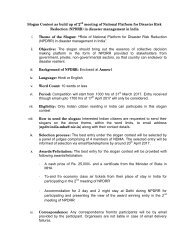National Disaster Management Guidelines School Safety Policy
School-Safety-Policy
School-Safety-Policy
You also want an ePaper? Increase the reach of your titles
YUMPU automatically turns print PDFs into web optimized ePapers that Google loves.
SCHOOL <strong>Safety</strong><br />
POLICY <strong>Guidelines</strong><br />
Section 3<br />
In addition, each district should designate the<br />
Block Education Officer or any other official as<br />
appropriate, for over-seeing and facilitating<br />
school safety at the block level.<br />
3.1.2 Institutional Strengthening at the<br />
Local Level for Preparedness and<br />
Response<br />
At the local level, both in rural as well as urban<br />
areas, the school community broadly includes<br />
children, school teachers, the Principal /<br />
Headmaster and parents. These are the primary<br />
stakeholders of the school affairs and may be<br />
represented formally or informally in decision<br />
making bodies for the school. It is imperative<br />
that these existing institutions at the school level<br />
are strengthened, and their potential adequately<br />
tapped for ensuring wellbeing of children and<br />
teachers from a disaster safety perspective.<br />
Under the SSA, the <strong>School</strong> <strong>Management</strong><br />
Committee has been designated as the body<br />
responsible for managing the affairs of the school in a<br />
transparent and “bottom – up” participatory manner.<br />
The <strong>School</strong> <strong>Management</strong> Committee needs to<br />
be made responsible for taking on the safety<br />
agenda at the community and school level. The<br />
<strong>School</strong> <strong>Management</strong> Committee needs to be<br />
sensitized and oriented on their expected role.<br />
At the school level, a <strong>School</strong> <strong>Safety</strong> Focal<br />
Point Teacher (FPT) needs to be nominated<br />
to operationally anchor safety related actions<br />
at the school level as part of his / her routine<br />
commitments in the <strong>School</strong>. The <strong>School</strong> <strong>Safety</strong><br />
Focal Point Teachers also need to be provided<br />
the necessary training to anchor the process and<br />
foster action by different stakeholders responsible<br />
for various activities.<br />
The <strong>School</strong> <strong>Management</strong> Committee in each<br />
school should be adequately trained for different<br />
aspects of school safety in case of an imminent<br />
disaster/emergency, e.g. sanitation and hygiene<br />
needs of boys, girls and teachers; first aid;<br />
stampede management; fire management<br />
and control, handling of chemicals /hazardous<br />
materials in labs etc.<br />
Each school should also identify and develop a<br />
cadre of peer educators / trainers for ensuring<br />
that safety messages, dos and don’ts of different<br />
disasters, procedures and protocols, reach each<br />
and every student in the school. These peer<br />
educators can be trained through <strong>National</strong> Cadet<br />
Corps, <strong>National</strong> scouts and guides camps, by<br />
the Red Cross or any other agency as deemed<br />
fit by the district.<br />
Many private schools have in place mechanisms<br />
to address everyday issues in relation to school<br />
expansion and development, fire drills, power<br />
outage procedures, early dismissals on account<br />
of unexpected weather events, health and safety<br />
concerns, trespassers or road/bus accidents.<br />
However the nature and effectiveness of these<br />
mechanisms varies. These mechanisms need to<br />
be made more inclusive as far as children are<br />
concerned as well as be more pro-active with<br />
regard to issues on safety.<br />
3.2 Planning for <strong>Safety</strong><br />
<strong>School</strong> safety planning needs to be undertaken<br />
at the district level as well as at the local /school<br />
level.<br />
3.2.1 Planning at the district level – links<br />
with district level DM efforts<br />
The District <strong>Disaster</strong> <strong>Management</strong> Plans (DDMPs)<br />
need to incorporate concerns and solutions for<br />
addressing safety related gaps in all the schools<br />
in the district and their surrounding environs.<br />
Moreover schools often serve as emergency<br />
shelter locations in the immediate aftermath of a<br />
disaster. Hence the DDMAs need to make sure that<br />
school safety is given due attention in the DDMPs.<br />
DDMP should, at the minimum include:<br />
● District level baseline of schools<br />
to be made safer. These can be<br />
assessed through ‘Rapid Visual<br />
Screening’ or any other tool to cover<br />
all hazards relevant to the area.<br />
● Proximity of emergency and crisis<br />
service agencies , their capabilities<br />
and consequently their expected<br />
response time;<br />
● Physical capacity of school<br />
infrastructure and facilities to resist<br />
known hazards that are relevant to<br />
the local context;<br />
● Information related to existing<br />
resources and capacities within<br />
the school and the community with<br />
regard to disaster management;<br />
12



